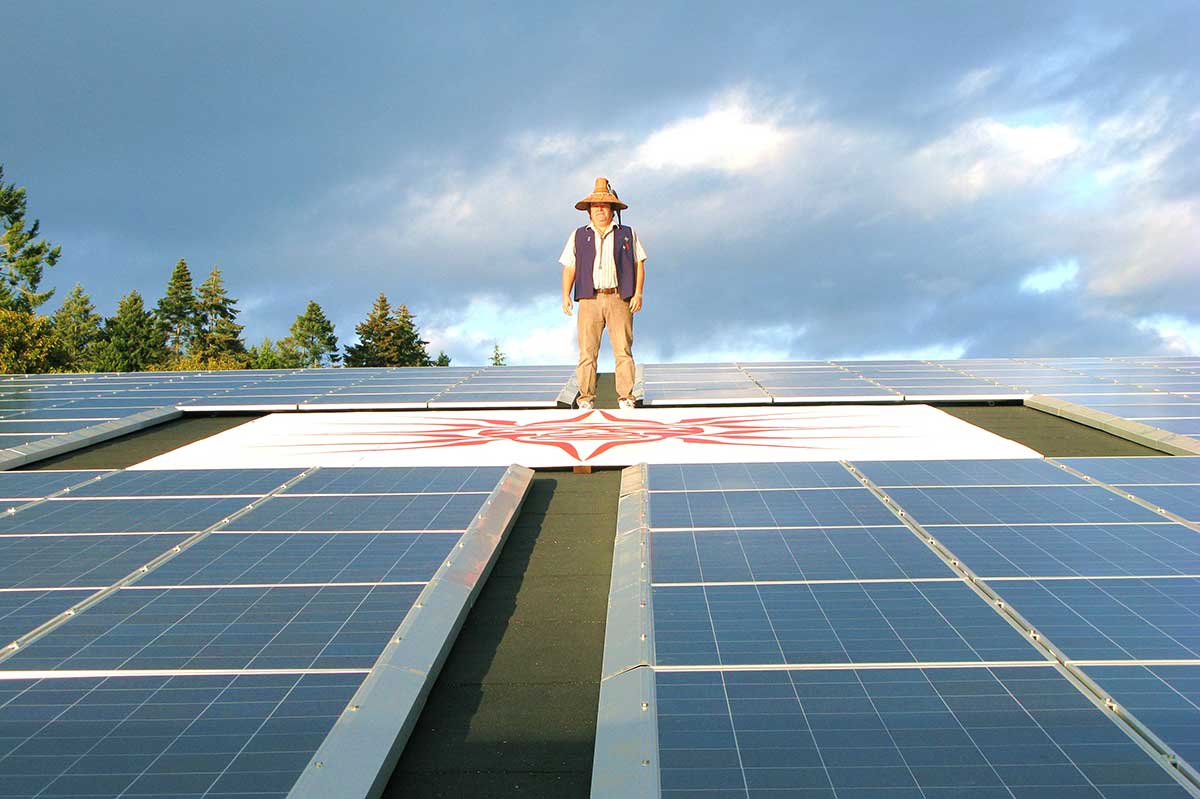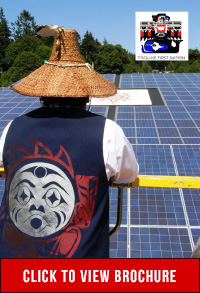Taking the Greener Path To Sustainability
“We should all use the gifts that the Creator has given us to help us give up our addiction to and dependency on fossil fuels and return once again to using the power of the elements: the Sun, Wind and Sea.” – Chief Gordon Planes
A small community of people residing near Sooke, British Columbia on the southern tip of Vancouver Island are making significant inroads when it comes to green energy and sustainability. Made up of about 250 members living on two reserves, the T’Sou-ke First Nation is proving to be a leader in the use of renewable energy in Canada. Not only will their efforts help their own community become increasingly self-reliant, but their work with other forward-thinking organizations is destined to have an impact globally.
Gordon Planes has served as Chief of the T’Sou-ke Nation since 2008 and is passionate about a need to return to ancestral roots by reviving and supporting the language, practices and traditions of the T’Sou-ke people. He feels equally strong about the need to explore forms of alternative energy, not just for the current membership but for future generations — part of a T’Sou-ke custom to “look ahead seven generations” or planning 100 years into the future.
“The demonstration project that we did, we did it for our children, and for our children not born yet,” Chief Planes explained. “Having that resource for future generations is so important. When we go to the other side, we’ve left something behind for the future generations to have that they can use and they’ll be able to do the same as well.”
That demonstration project launched in 2009 was a turning point for the T’Sou-ke Nation, allowing the village to generate its own power through a 440-panel solar photovoltaic system. Hot water solar panels were installed on close to half of the reserve’s buildings, leading to a surplus in energy that the T’Sou-ke Nation sells to BC Hydro during the summer and buys back as needed in the winter, resulting in net-zero energy costs.
Project draws worldwide attention
An unexpected offshoot of the demonstration project was the attention the village received from thousands of people worldwide, Chief Planes said. University students, members of other First Nations and company representatives all arrived at the T’Sou-ke Nation reserve to tour and learn more about the project.
Since then, the First Nations community has become involved in additional green initiatives. A solar-powered electric car charging station is located outside of the administrative offices. In 2013, the T’Sou-ke Nation was approached by TimberWest Forest Corp. and EDP Renewables Canada to develop a $750-million wind project that could potentially power 75,000 homes. But the project was halted when BC Hydro, a potential customer, decided to invest in its Site C hydroelectric dam on the Peace River.
Undaunted, the T’Sou-ke Nation continued to explore opportunities for sustainable living. Their community greenhouses are not only being used to grow food for the village, but they have also become cash crop farmers through an agreement with Pacific Coast Wasabi. Three greenhouses were constructed for the growing and harvesting of wasabi with sales going to the food, herbal dietary supplement and biomedical markets. The project has provided training and jobs in both the construction of greenhouses and the growing and harvesting of food.
Community greenhouses are just one part of the T’Sou-ke Nation’s movement towards a zero-mile diet. Food security is one of four priorities stemming from a comprehensive community planning process, which also focuses on energy security, cultural renaissance and economic self-sufficiency. Creating food security means tapping into ancestral roots.
“Everything that we ever needed was right in front of us in the villages. We are the salmon people but we relied on the food source that was around us, that is the deer, even seals,” Chief Planes said. “If you have a healthy environment, you have healthy people as well. We need to make sure all of the beaches are clean so we can go and harvest our clams when we want, and also to bring back the Olympic oyster, an endangered species. All of those food sources, even in our mountains, those are so important.”
Instilling respect in the next generation
Passing those messages on to the younger generation and instilling a respect for Mother Earth by getting children on to the land is key. “The zero-mile diet is just getting our kids used to food that our ancestors collected every day so that they don’t take things for granted. For us, our way of life has always been on the land and on the water and it’s getting back to that. You’re taking away the dependencies. Everyone has to go to a grocery store to buy their food. Our grocery store is right in front of us…”
Solar most often comes to mind when talking about alternative forms of energy. But the T’Sou-ke Nation is exploring options that go beyond the sun. Last year, they partnered with Accumulated Ocean Energy Inc. (AOE) to work towards advances in the area of ocean wave energy production. Still in its infancy, the project would transform wave energy into highly compressed air, which could be pumped to shore and stored as an energy medium.
Another exciting option for the future would involve airborne wind systems, also known as kite energy. Chief Planes spoke at the 2015 Airborne Wind Energy Conference at Delft University of Technology in the Netherlands. The T’Sou-ke Nation has been in discussions with Swiss-based TwingTec to launch another demonstration project highlighting wind power. By utilizing a Twing — a tethered wing that looks similar to a small glider— TwingTec can harness wind energy up to 300 metres above the ground.
New project with Schneider Electric
Last September, Schneider Electric, which specializes in energy management and automation, announced that Sustainable Development Technology Canada (SDTC) would help to fund the commercialization of its Smart Energy Storage Solution (SmartESS) inverter. The contract would allow Schneider to partner with T’Sou-ke Nation to develop inverter solutions, bringing additional energy options to the community.
The SmartESS platform is a transformer-less, all-in-one, wall-mounted inverter that combines a hybrid battery and solar photovoltaic (PV) inverter. The project was expected to create a connected and integrated solution that would provide increased performance and reliability at reduced costs. The inverter is ideal for the T’Sou-ke Nation because it has been designed to address the power and energy needs of residences, small commercial businesses, off-grid communities and energy service providers.
Though the project is currently on hold, there is an expectation that it will go ahead in the future, Chief Planes said. New projects with Schneider Electric, among other companies, are also underway, aiming to reduce the reliance on diesel generation. The T’Sou-ke Solar Diesel Displacement Demonstration project began in 2014 and has brought together organizations like Global Microgrid and Shipstone Corporation — people who have worked for decades to promote sustainability. The project has also received support from Sustainable Development Technology Canada (SDTC).
Daniel Kenway is President of Shipstone Corp. and a long-time friend of Chief Planes. He recalled sitting in Planes’ office, overlooking the sea, where they would dream about ways to effect change. “This is all from the personality of Gordon who is truly a very gracious, gentle and well-managed visionary,” Kenway said. “He’s really got it together.”
There is a serious problem in Canada, particularly for the approximately 200,000 people living off the grid, many of whom reside in remote First Nations, Kenway said. For most, the only source of power is diesel electricity but through the demonstration project, a good portion of energy reliance will shift to more sustainable solar power.
“We are basically blending power so that you can bring in solar power and make it coexist with diesel,” Kenway said. The technology would allow the diesel power source to shut down when operating off solar energy. “This is like a disruptive revolution where First Nations that once upon a time were dependent on provincial hydro to put in diesel are taking charge of their own power systems.” The potential is there to hugely reduce the reliance on diesel-generated electricity.
“(Gordon’s) nation is a few hundred people but the changes he’s effecting affects thousands and thousands of people. People can take their own power back,” Kenway said.
“What’s happening today is good, but in 10 years from now it’s even going to be better and keep getting better,” Chief Planes said. Exploring ways to transform the power of the elements — the sun and wind and sea — provides a direct path to reducing the reliance on fossil fuels, something that resonates strongly with First Nations people.
Alternative energy mimics the past
“The good thing about alternative energy is it mimics what we did in the past. When you go in a canoe, you have so many ways of travelling. Number one is you use your paddle with the people paddling, number two is you use the sail that would use the wind to help propel you to where you have to go, and you also use the tide,” Chief Planes explained. “In the past, we did not have gasoline, combustion engines. The environment was our energy — that energy coming from the wind, coming from the tide. If you think about it now, look at what we’re doing with alternative energy. We’ve been doing this since time in memorial in regards to sustainability. We didn’t have to go far for food; the modes of transportation were the environment. If you take care of the environment, the environment takes care of you.”
For Chief Planes and the rest of the T’Sou-ke Nation, the move towards sustainability and alternative energy is a journey that has just begun. Rooted in the traditions of their ancestors, the T’Sou-ke Nation people are working to come full circle with outcomes that could benefit all of Canada.
“There’s got to be a balance and you’ve got to learn the balance. All the teachings are sitting right there and we’ve just got to make sure that we always use them. They’re right in front of us.”







